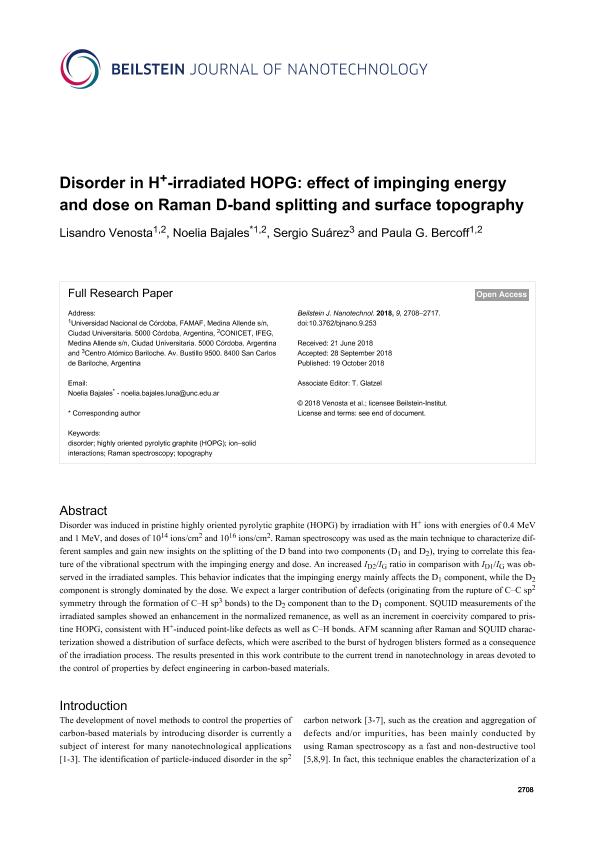Artículo
Disorder in H+-irradiated HOPG: Effect of impinging energy and dose on Raman D-band splitting and surface topography
Venosta, Lisandro Francisco ; Bajales Luna, Noelia
; Bajales Luna, Noelia ; Suarez, Sergio Gabriel
; Suarez, Sergio Gabriel ; Bercoff, Paula Gabriela
; Bercoff, Paula Gabriela
 ; Bajales Luna, Noelia
; Bajales Luna, Noelia ; Suarez, Sergio Gabriel
; Suarez, Sergio Gabriel ; Bercoff, Paula Gabriela
; Bercoff, Paula Gabriela
Fecha de publicación:
19/10/2018
Editorial:
Beilstein-Institut
Revista:
Beilstein Journal of Nanotechnology
ISSN:
2190-4286
Idioma:
Inglés
Tipo de recurso:
Artículo publicado
Clasificación temática:
Resumen
Disorder was induced in pristine highly oriented pyrolytic graphite (HOPG) by irradiation with H+ ions with energies of 0.4 MeV and 1 MeV, and doses of 1014 ions/cm2 and 1016 ions/cm2. Raman spectroscopy was used as the main technique to characterize different samples and gain new insights on the splitting of the D band into two components (D1 and D2), trying to correlate this feature of the vibrational spectrum with the impinging energy and dose. An increased ID2/IG ratio in comparison with ID1/IG was observed in the irradiated samples. This behavior indicates that the impinging energy mainly affects the D1 component, while the D2 component is strongly dominated by the dose. We expect a larger contribution of defects (originating from the rupture of C-C sp2 symmetry through the formation of C-H sp3 bonds) to the D2 component than to the D1 component. SQUID measurements of the irradiated samples showed an enhancement in the normalized remanence, as well as an increment in coercivity compared to pristine HOPG, consistent with H+-induced point-like defects as well as C-H bonds. AFM scanning after Raman and SQUID characterization showed a distribution of surface defects, which were ascribed to the burst of hydrogen blisters formed as a consequence of the irradiation process. The results presented in this work contribute to the current trend in nanotechnology in areas devoted to the control of properties by defect engineering in carbon-based materials.
Archivos asociados
Licencia
Identificadores
Colecciones
Articulos(IFEG)
Articulos de INST.DE FISICA ENRIQUE GAVIOLA
Articulos de INST.DE FISICA ENRIQUE GAVIOLA
Citación
Venosta, Lisandro Francisco; Bajales Luna, Noelia; Suarez, Sergio Gabriel; Bercoff, Paula Gabriela; Disorder in H+-irradiated HOPG: Effect of impinging energy and dose on Raman D-band splitting and surface topography; Beilstein-Institut; Beilstein Journal of Nanotechnology; 9; 1; 19-10-2018; 2708-2717
Compartir
Altmétricas



